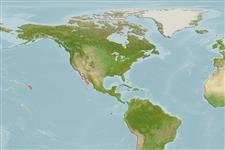>
Blenniiformes (Blennies) >
Chaenopsidae (Pike-, tube- and flagblennies)
Etymology: Coralliozetus: Greek, korallion = coral + Greek, ketos = a marine monster, whale (Ref. 45335).
More on authors: Beebe & Tee-Van.
Environment: milieu / climate zone / depth range / distribution range
Ecologia
marinhas associadas(os) a recifes; intervalo de profundidade 1 - 3 m (Ref. 11482). Tropical
Eastern Central Pacific: Baja California, Mexico and the Gulf of California.
Tamanho / Peso / Idade
Maturity: Lm ? range ? - ? cm
Max length : 4.0 cm TL macho/indeterminado; (Ref. 11482)
Found in shallow waters and in calm rocky areas (Ref. 37955). Inhabits mollusk tubes and barnacles on rocky reefs (Ref. 11482). Feeds on zooplankton (Ref. 11482).
Ciclo de vida ou comportamento de acasalamento
Maturities | Reprodução | Spawnings | Egg(s) | Fecundities | Larvas
Allen, G.R. and D.R. Robertson, 1994. Fishes of the tropical eastern Pacific. University of Hawaii Press, Honolulu. 332 p. (Ref. 11482)
Status na Lista Vermelha da UICN (Ref. 130435)
Ameaça para os humanos
Harmless
Uso pelos humanos
Ferramentas
Relatórios especiais
Baixar XML
Fontes da internet
Estimates based on models
Preferred temperature (Ref.
123201): 22.3 - 28.5, mean 25.2 °C (based on 170 cells).
Índice de diversidade filogenética (Ref.
82804): PD
50 = 0.5156 [Uniqueness, from 0.5 = low to 2.0 = high].
Bayesian length-weight: a=0.00457 (0.00183 - 0.01143), b=3.08 (2.86 - 3.30), in cm total length, based on LWR estimates for this (Sub)family-body shape (Ref.
93245).
Nível Trófico (Ref.
69278): 3.4 ±0.45 se; based on food items.
Fishing Vulnerability (Ref.
59153): Low vulnerability (10 of 100).
Nutrients (Ref.
124155): Calcium = 236 [108, 510] mg/100g; Iron = 0.979 [0.502, 1.844] mg/100g; Protein = 18 [17, 19] %; Omega3 = 0.0921 [, ] g/100g; Selenium = 11.5 [4.5, 31.6] μg/100g; VitaminA = 479 [126, 1,789] μg/100g; Zinc = 2.59 [1.55, 4.15] mg/100g (wet weight);
